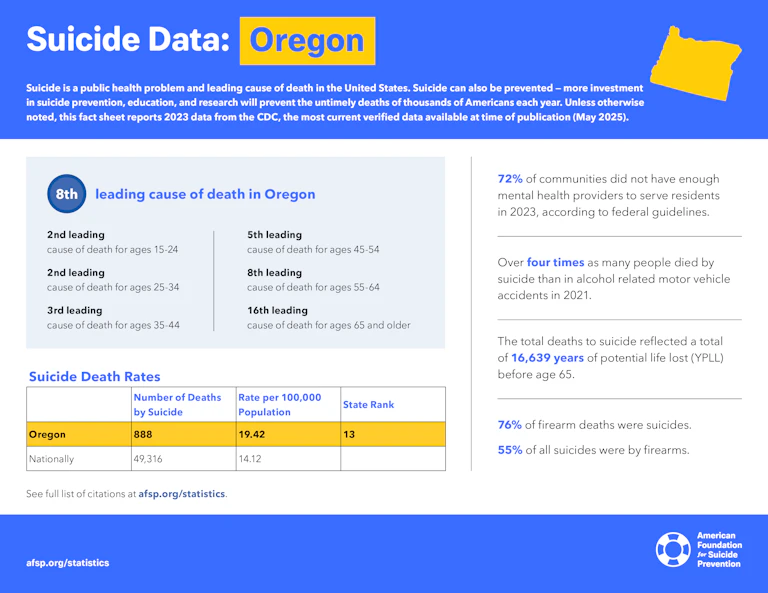Oregon

Oregon suicide prevention plans and initiatives
Oregon’s suicide prevention activities are housed within the Oregon Health Authority (OHA) Public Health Division’s Injury and Violence Prevention Section, and suicide prevention is a focus area of OHA’s 2020-2024 State Health Improvement Plan. Oregon law provides for a Youth Suicide Intervention and Prevention Coordinator within OHA to facilitate development of a statewide plan and to update the plan every 5 years (ORS §§ 418.731 & 418.733), and it also establishes a related Advisory Committee to advise OHA and consult with the Coordinator on updates to the plan and annual reports to the legislature ORS § 418.726). The most recent version of the Youth Suicide Intervention and Prevention Plan (YSIPP) covers 2021-2025, and while it contains some new and innovative pieces, it is firmly rooted in the work done for years by suicide prevention champions across Oregon. The plan is the natural continuation of that work and captures the lessons learned over the previous five years, laying out a vision for what else must be addressed to keep moving toward health and wellness for Oregon's youth. In addition, Oregon has also implemented two bills, H.B.3426 and H.B. 2757, which provided additional funding towards the 988 initiatives, and required 988 centers to receive specific training regarding certain at-risk groups.
The biggest development in the most recent YSIPP is the integration of the Oregon Suicide Prevention Framework, which focuses on suicide prevention across the lifespan, the long-term vision for suicide prevention in Oregon. The OHA suicide prevention team now includes five coordinators working in three scopes – youth suicide, adult suicide, and Zero Suicide initiatives in healthcare – who will use the framework's strategic pillars and goals to guide their work and develop specific strategic pathways and related strategic priority initiatives within their scope of work.
Oregon laws
Key:
- Required by law
- Encouraged by law
- No law in place
Crisis lines and 988 implementation
- Addresses 988 infrastructure and provides for telecom user fee
- Addresses 988 infrastructure but does not include telecom user fee
- 988 law limited to creating an exploratory commission, advisory committee, or task force
Mental health parity
- Public health plans (e.g., Medicaid) regularly submit parity compliance analyses to state regulators
- Private health plans (individual and group) regularly submit parity compliance analyses to state regulators
K – 12 school suicide prevention
- Inclusion of the 988 Suicide & Crisis Lifeline and/or other crisis line(s) on student ID cards
- Student allowances for excused mental health absences
- School personnel must report student suicide risk to a parent and/or guardian
- Suicide prevention and/or mental health training for certain school personnel, annual
- Suicide prevention and/or mental health training for certain school personnel, not annual
- Suicide prevention, intervention, and postvention policies/programming
- Student education on suicide prevention
Health professional training in suicide assessment, treatment and management
- Mental health professionals receive regular training
- Mental health professionals receive one time training
- Medical/surgical professionals receive regular training
- Medical/surgical professionals receive one time training
Conversion therapy bans
- Prohibits licensed/board certified mental health providers from engaging in conversion therapy with minors under 18 years of age
- Prohibits licensed/board certified mental health providers from engaging in conversion therapy with vulnerable adults
- Prohibits use of state funds for any purpose related to conversion therapy (e.g., conducting, making a referral for, or extending health benefits coverage for)
University and college campus suicide prevention
- Inclusion of the 988 Suicide & Crisis Lifeline and/or other crisis line(s) on student ID cards
- Students receive information on available mental health and/or suicide prevention services and/or resources
- Adoption of suicide prevention/awareness policy or program
Firearms
- Process for extreme risk protection orders (ERPOs)
- State voluntary do not sell list